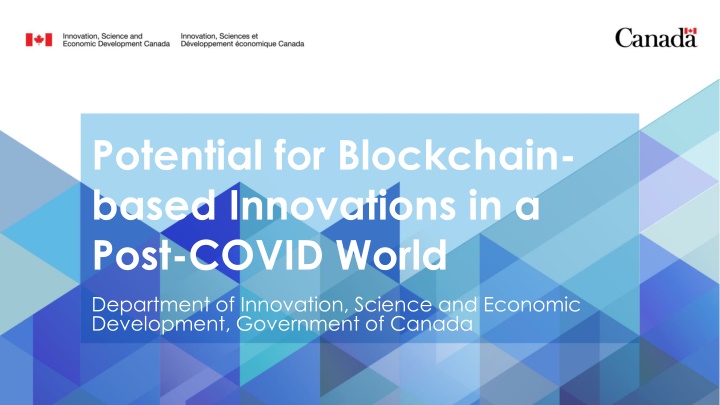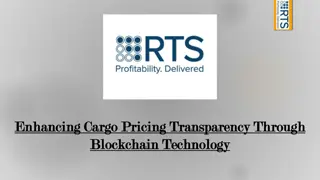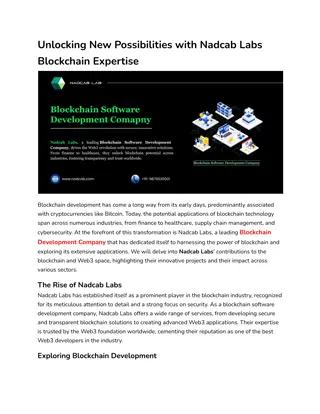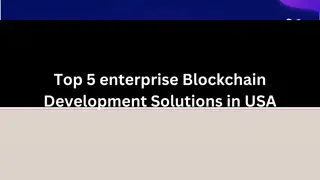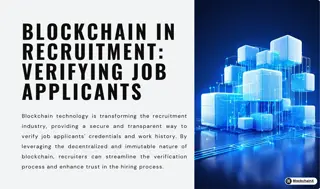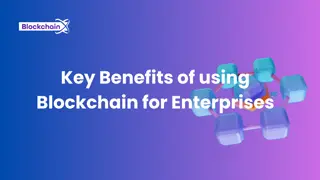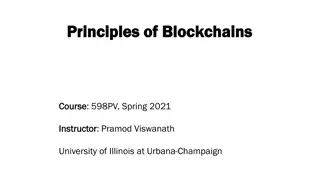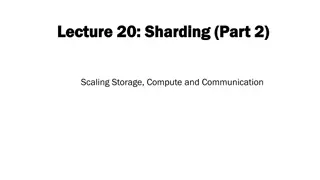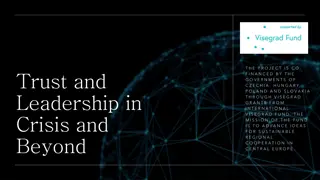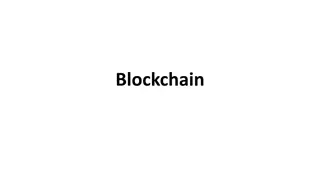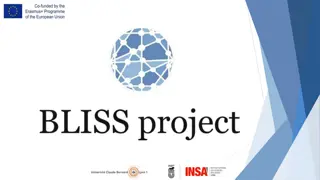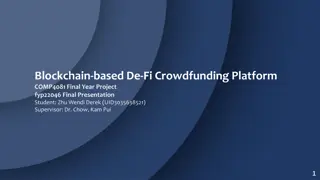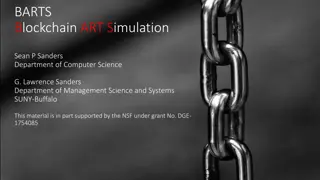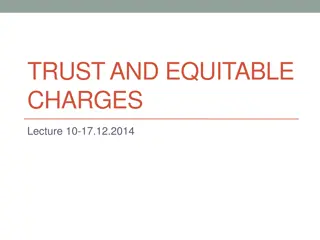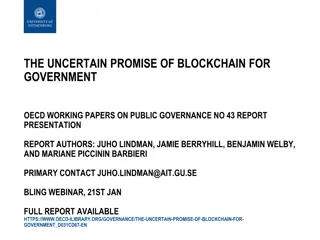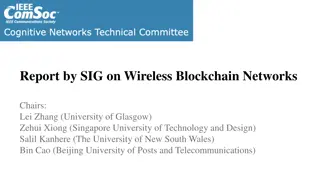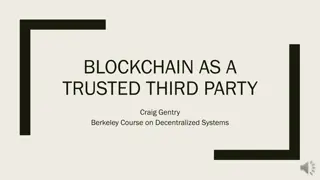Leveraging Blockchain for Enhanced Trust and Efficiency Post-COVID
The Department of Innovation, Science, and Economic Development in Canada explores the potential of blockchain technology in a post-COVID world. By digitizing documents and enabling trust online, governments can respond faster to crises, support a digital economy, and establish a more open society. Key priorities include digital credentials, infrastructure, and addressing COVID-19 challenges through high-level use cases.
Download Presentation

Please find below an Image/Link to download the presentation.
The content on the website is provided AS IS for your information and personal use only. It may not be sold, licensed, or shared on other websites without obtaining consent from the author.If you encounter any issues during the download, it is possible that the publisher has removed the file from their server.
You are allowed to download the files provided on this website for personal or commercial use, subject to the condition that they are used lawfully. All files are the property of their respective owners.
The content on the website is provided AS IS for your information and personal use only. It may not be sold, licensed, or shared on other websites without obtaining consent from the author.
E N D
Presentation Transcript
Potential for Blockchain- based Innovations in a Post-COVID World Department of Innovation, Science and Economic Development, Government of Canada
Context COVID-19 has surfaced the risk of relying on in-person and paper based processes to conduct transactions. Governments and organizations that rely largely on these processes have been either unable to or delayed in delivering services. In the post-COVID world, individuals and businesses will likely expect faster responses from governments and organizations, and want to transact digitally across the economy. 2
Trust and Blockchain The essential part of any transaction is trust, or in other words, being assured that any claim made by a transacting party is true. Government is a trust anchor in society and facilitates trust in society and the economy through various means, such as issuing individual and business identity, licences and permits and making information publicly available to support the public good. Governments can enable trust online by providing digital versions of these documents, that could be verified through Blockchain, to support the COVID-19 response and enable a 3
Key Priorities Digital Economy COVID-19 Response Digital and Open Society Digital Credentials (Identity, licences and permits, claims) Digital Infrastructure, enabled by Blockchain 4
Potential High-level Use Cases Responding to COVID-19 Supporting re-opening of businesses (e.g., start or close operations as warranted by the health crisis). Supporting movement of individuals and businesses providing essential goods and services across provincial and national borders (e.g., activities deemed to be essential). Supporting return to work (e.g., proof of vaccination or negative testing result for to COVID-19) Enabling a digital economy Easing regulatory compliance by making it quicker and easier for individuals and businesses to prove their authority to conduct activities (e.g., liquor licence) and comply with regulations (e.g., Know Your Clients (KYC), Anti-Money Laundering (AML)) Facilitating trading of goods and services across international borders (e.g., import licences) Identifying proof of origin and verifying product claims (e.g., environmental and social criteria) Facilitating individual-to-business and business-to-business digital transactions. Supporting a Digital and Open Society Establishing digital identity for individuals and businesses (e.g., identity, qualifications) Enabling international travel (e.g., digital passports) Making it quicker and easier to obtain social and economic benefits from governments (e.g., auto- completing applications and real-time validation) Supporting transparency (e.g., government contracts) 5
Sample Use Case 1: Opening a Bank Account Transactions with governments and other businesses (e.g. banks) can be costly and time-consuming for SMEs. Many of the transactions involve slow and manual processes with the added burden of paper-based documents. Verifying the authenticity of paper-based documents and manually-inputted information is costly and time-consuming for service providers. Makes it challenging for service providers to meet Canadian KYC and AML requirements. 6
Sample Use Case 1: Opening a Bank Account (concept diagram under development) We used your provincial digital credential to verify your identity, incorporate your business federally and then register in your province. We used your provincial and federal digital credentials to verify you and your corporation and to open your new bank account. I want to open a bank account for my new federal corporation. I want to incorporate my business federally and operate in my province. Thank you for making this quick and easy so I can focus more on my business. Shares provincial individual digital credential and provides registration information. Shares individual and business digital credentials Issues business digital credentials Issues bank account digital credentials Digital Wallet Corporations Canada and provincial corporate registry Business Owner Business Owner Bank Representative Business Owner Digital Credentials (previously issued) Verifies authenticity of the information and the issuer Credential Issuers (i.e., provincial issuer) Writes information used to verify the authenticity of the information and the issuer Blockchain Client information is stored in the client s digital wallet, not on the Blockchain Businesses save time when transacting with government and other businesses 7
Sample Use Case 2: Natural Gas Sold Directly A federally incorporated natural gas operator in B.C. wants to sell natural gas in California. Potential purchasers in California only want to buy gas that meets or exceeds Environmental, Social and Governance (ESG) benchmarks. In addition, U.S. Customs and Border Protection wants to know the point of origin and purchaser/destination of any goods entering the U.S. to determine what (if any) tariffs to apply. Engaging in cross-border trade can be costly and time-consuming for SMEs and government entities, often requiring businesses to provide paper-based documents. 8
Sample Use Case 2: Natural Gas Sold Directly (concept diagram under development) We can transport the natural gas on our pipeline system. Terms are in the Firm Transportation Service Agreement (FTSA). I want to purchase natural gas that exceeds global ESG benchmarks. Your product meets our needs. Terms are in the Gas Purchase Agreement (GPA). I want to receive the natural gas that was purchased. I need to transport the natural gas to the purchaser. I want to sell natural gas in the U.S. Shares digital credentials (e.g., Identity, operating licence, GPA) Shares digital credentials (e.g., identity, ESG ratings, point of origin, export licence) Shares digital credentials (e.g., Identity, export licence, GPA) Issues GPA credential Digital Wallet Issues FTSA credential and provides access to the natural gas Issues FTSA credential Natural Gas Transporter (Pipeline Owner) U.S. Natural Gas Purchaser Canadian Natural Gas Producer & Seller Shares digital credentials for reporting (e.g., identity, GPA, export licence) Shares digital credentials for tariffs and reporting (e.g., point of origin, GPA, FTSA) U.S. Regulatory Credential Consumers (e.g., CBP, FERC) Credential Issuers (e.g., Provincial Government, Corporations Canada, ESG Assessment Entity, Canada Energy Regulator) Credential issuers (e.g., State-Level Public Utilities Regulator, Department of Energy) Canadian Regulatory Credential Consumers (e.g., CER, CBSA, provincial regulator) Issuers write information to a Blockchain to verify the authenticity of the information and the issuer Consumers use the Blockchain to verify authenticity of the credential and the issuer Blockchain Client information is stored in the client s digital wallet, not on the Blockchain Selling and Exporting Natural Gas to the United States
Key Issues facing Blockchain-based Innovations 1. Technology Maturity: Identifying the approach to assess and conduct due diligence on the digital Iinfrastructure and relying applications*. 2. Ecosystem: Identify approaches to establish an ecosystem of issuers and consumers 3. Governance: Identifying stakeholders to govern the infrastructure and relying applications. 4. Interoperability: Developing standards to ensure interoperability between digital infrastructure technologies, relying applications and legacy systems. 5. Security and Privacy: Approaches to ensuring ongoing security and protection of privacy. 6. Operations: Whether the digital infrastructure and relying applications should be operated by government, by the private sector or jointly. 7. Education and Training: Approaches to ensuring sufficient skill-sets and capacity within government. 8. International Cooperation: Identifying opportunities for collaboration with other countries and international fora on digital infrastructure and relying applications. 9. Policy and Regulatory Alignment:Identifying the policy or regulatory alignment that could be required. 10. Action Plan: Proposing an action plan to support establishment of the digital infrastructure. * relying applications refers to solutions built on blockchain such as Digital Credentials, held in Digital Wallets and public repositories. 10
Open Discussion How are you approaching blockchain-based innovations? Role of Government in establishing Digital Infrastructure, enabled by Blockchain Welcome your thoughts on how to kick-start the ecosystem Opportunities for collaboration 11
Annex: Pan-Canadian Trust Framework (PCTF) PCTF is a set of criteria and specifications to ensure jurisdictions abide by a common, agreed-upon set of rules to trust and accept each other s digital identities Economic opportunities conservatively estimated at $15+ Billion (1% of GDP) if Trusted Digital Identity is enabled in Canada The focus is Digital Identity to enable Canadians (i.e., individuals and businesses) to have a trusted, streamlined, and secure way of transacting in a digital economy Benefits improve trust and efficiency, while reducing fraud (Digital Identification and Authentication Council of Canada CIOSC Presentation Nov. 2018) Guiding principles supporting the PCTF development Privacy and security respected Convenience and choice for citizen sharing identity information 12
